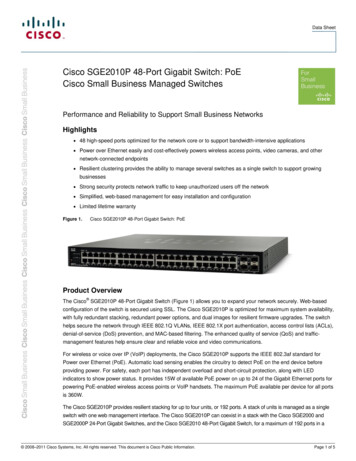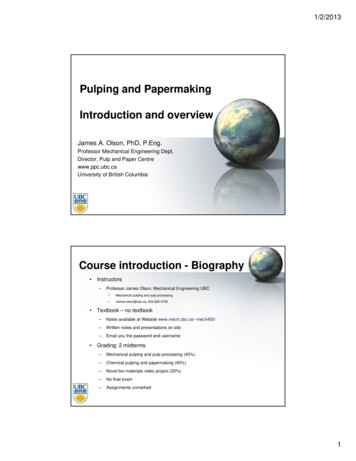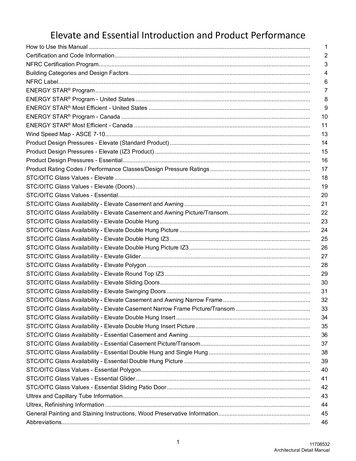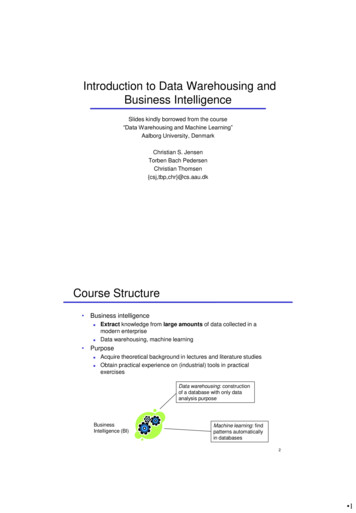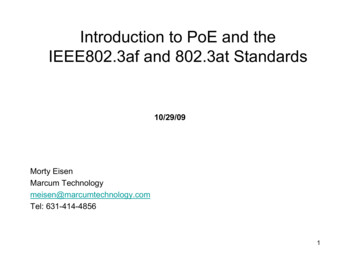
Transcription
Introduction to PoE and theIEEE802.3af and 802.3at Standards10/29/09Morty EisenMarcum Technologymeisen@marcumtechnology.comTel: 631-414-48561
Marcum LLP and Marcum Technology Marcum LLP is one of the largest independent public accountingand advisory services firms in the nation. Marcum Technology is a member of the Marcum Group, thegateway to a group of organizations that provide a variety ofprofessional services including accounting and advisory,technology solutions, recruiting, wealth management andmarketing and design. Marcum LLP Highlights:– Ranked 20th among the "Top 100 Firms" in the nation– Largest accounting and advisory services firm on Long Island– 800 professionals, including 101 partners, in 12 locations spanning theEast Coast– Named among the "Best Companies to Work for in New York“ Marcum Technology focuses on Storage, Disaster Recovery,Infrastructure, Messaging & Security2
This Talk is about Power Over Ethernetnot About Edgar Allen PoeThe RavenOnce upon a midnight dreary,while I pondered, weak andweary,Over many a quaint and curiousvolume of forgotten lore,While I nodded, nearly napping,suddenly there came a tapping,As of some one gently rapping,rapping at my chamber door."'Tis some visitor," I muttered,"tapping at my chamber door Only this, and nothing more."Edgar Allan Poe3
Introduction to Power over Ethernet (PoE) Power over Ethernet or PoE technologydescribes a system to safely transfer electricalpower, along with data, to remote devices overstandard data cables in an Ethernet network(Cat3/Cat5/Cat5e/Cat6 ). The original IEEE 802.3af-2003 standard versionof PoE supplies up to 15.4 W of DC power(minimum 44 VDC and 350 mA) to each device.Only 12.95 W is assured to be available at thepowered device (PD) as some power isdissipated in the cable. No affect on network performance of 10/100/1000Mbps links to the PD.4
Introduction to Power over Ethernet(Cont.) Power is remotely supplied from a central location (e.g. wiringcloset) for distances under 100 meters without the Ethernetdevices having to be individually powered by an AC outlet. PDs include IP Phones, Wireless LAN Access Points, IP SecurityCameras and various other network devices IEEE 802.3af-2003 standard specifies Power over Ethernet (PoE)technology in two different methodologies:– Power-Supplying Equipment (PSE) may use eitherEnd-Span or Mid-Span– Powered devices (PD’s) accept power from either type of powersource Over 70 million PoE PSE ports shipped in 2008http://www.poweroverethernet.com/5
PoE Key Benefits Installation Cost Savings–––Eliminates the need for electrical outlet installationDramatically reduces cost of deployment – savings up to 1,000 per PDNo need for bulky AC power adaptors Simplifies Installation–Uses a single Cat5/5e/6 cable for both data and power Centralized Power Backup–Continuous operation during power interruptions Centralized Power Management–Devices can be remotely powered down during periods of low usage or for securitypurposes SAFE Power–Will not damage Non-PoE devices or legacy peripherals6
PoE Switch PSE End-SpanUPS – Battery BackupIEEE 802.3af CompliantPoE SwitchPSEPD’sVoIP Phones NetworkCamerasWireless LANAccess Points7
Power Originating from an End-Span(Ethernet Switch)End-Span technology -Power originates from a powered port on anEthernet Switch and is super-imposed on data transmission wire pairs1,2,3, and 68
Switch PoE Injector PSE Mid-SpanUPS – Battery BackupEthernet SwitchData InPSEMid-SpanData & Power OutPD’sVoIP PhonesNetworkCamerasWireless LANAccess Points9
Power Originating from an ExternalMid-Span DeviceMid-Span technology-Power is added to the non-data wire pairs 4,5,7,and 8 from a patch-panel style hub10
Power over Ethernet PDsVoice and Video IP PhonesWiFi Access Points a/b/g/nNetwork Security Cameras – Enclosures – Heaters – Pan and TiltBuilding / Access Control – Gas and Fire Alarms – Digital SignsDigital and School Clocks – SIP IP Paging – Door locks - Gateways11
Sample PD CircuitLM5071 - Power Over Ethernet PD Controller with Auxiliary PowerFully Compliant 802.3af Power Interface Porthttp://www.national.com/analog/power/hv/poe12
Splitters for PoEActive PoE Splitters allow PoE power on non-PoE devicesTypical Splitters Feature Safe Power with IEEE detection IEEE connect and disconnection 10/100/1000Data (RJ45)DC Power andConnectorDC Power andConnector13
PoE Splitters Application ExampleDataData & PowerPowerPowerData & PowerData14
IEEE802.3af Distance LimitationsStandard Ethernet distance rules applyPoE Switch50 ft300 ft1 Port PoE (Repeater)Allows up to an additional330 ft75 ft100 ft300 ftMaximum distance from the switch100 meters or 333 feetEven if you are using a mid-span15
PoE Market SizeProjected 25 % growth rates for PDs and PSEsNumber of PoE Ports16
Market and Competitive Analysis Ethernet Switch Ports: This report estimates that global shipmentsof PoE-enabled ports in enterprise switches are expected to reachover 132 million ports in 2012. By 2012, PoE ports will represent onequarter of all enterprise Ethernet ports. Mid-Spans:. Mid-Span shipments will be healthy over the nextseveral years as people who have not yet deployed PoE or PoEPlus switches will still want to take advantage of PoE benefitswithout having to purchase new switch gear. PDs: In 2007, shipments of PoE-enabled business IP phonesexceeded 10 million units. VDC expects shipments of enterprisewireless LAN access points to grow to 11.2 million units in 2012. PoE Controllers: There are only two vendors who have anysignificant market share of PSE controllers, Linear Technology andMicrosemi. The PD controller market is a bit more fragmented, withseveral companies having significant market share in 2007.Power Over Ethernet (POE): Global Market Demand Analysis Third EditionResearch Report # VDC6526Publication Date: March 2008VDC Research17
Partial PoE Vendor List 3COM CORPORATIONAKROS SILICON, INCARUBA NETWORKS, INCAVAYAAXIS COMMUNICATIONSBROADCOM CORPORATIONCISCO SYSTEMS, INCDVTEL, INCENTERAYS NETWORKS, INCHEWLETT-PACKARD COMPANYHID GLOBALLINEAR TECHNOLOGY CORPORATIONMICROSEMI, INC (PowerDsine)MITEL NETWORKSMOTOROLA, INCNATIONAL SEMICONDUCTOR CORPORATIONPANDUIT CORPORATIONPHIHONGPOLYCOM, INCSIFOS TECHNOLOGIESSILICON LABORATORIES, INCSILVER TELECOMTEXAS INSTRUMENTS,Special thanks to slides and material from Microsemi, Phihong, Sifos, Ciscoand National Semiconductor.18Microsemi, Phihong, Motorola (Symbol), & others have PoE engineers in Long Island
PoE Original Standard (802.3af-2003) IEEE802.3af (15.4W/port)– Approved in 2003 for PDs up to 12.95W (350mA) at 48V DC– PoE requires handshake before applying power– Power Sourcing Equipment (PSE) transmits power over2 pairs (4 of 8 wires) on Cat5/5e/6 cable– Connect/disconnect protocol for applying/disconnecting power– Detect device that needs power Determines power needed When to turn on power Detect device disconnect (AC and DC disconnect) When to remove powerPhysical layer mechanism for PSE’s to characterize power demands of individual PD’sand thus manage power delivered per port.http://www.ieee802.org/3/af/index.html19
PoE Operation Modes with Respectto Input Voltage20
802.3af Power ClassificationIn the start-up process when a PoE connection is made, the PD canadvertise its power class which is an indication of how much power isrequiredClassMin. PSE PowerMax. PD PowerSample PD’s14 Watts3.84 WattsIP Phones27 Watts6.49 WattsIP Camera3,4, or 015.4 Watts12.95 WattsWireless AP“Power cannot be forced down the cable” - a common misconception The PD presents a load to the cable and draws as much as it needs. MostPoE powered devices will draw a fixed level of power.21
IEEE802.3at Project Milestones Nov-2004: Study Group Created Jul-2005: IEEE802.3 recommended creation of TaskForce Sep-2005: IEEE802.3at Power over EthernetEnhancements Task Force Created Jan-2009: New Orleans, LA (interim) – last meeting– All comments on draft 3.3 addressed, draft 4.0created, sponsor ballot Mar-2009: Vancouver, BC (plenary) Sep 11 2009: Ratification22
IEEE802.3at Objectives At least 24W power supplied to the PD– As much as economically feasible Backwards compatible with IEEE802.3af-2003– Type 2 PD’s that cannot operate with less than 12.95W mustgive indication to user when connected to Type 1 PSE– Type 2 PD’s that can operate with less than 12.95W must beable to be powered by a Type 1 PSE PD MIB to be created Support for Gigabit MidspanType 1: “low power”Type 2: “high power”23
Devices Evolve and Require More Power Access Points migration to 802.11n–––Cisco AP-1200 with g radio : 802.3af (6.5W)Cisco AP-1200 with a g radios : 802.3af (11.6W)Cisco AP 1250 for 802.11n : (20 W) Migration to Advanced Network Cameras–––Sony SNC-Z20N Zoom Camera : 802.3af ( 12.95W)Sony SNC-RZ30N Pan/Tilt/Zoom : (21.6W)Sony SNC-RZ30N Pan/Tilt/Zoom/Heated Enclosure : (50W) IP Phones evolving into Video Phones––––Wooksung Video Phone : 18.4WPacket8 Video Phone : 25WLeadtek IP Broadband Video Phone : 25WWorldGare Video Phone : 36W24
IEEE 802.3af EnhancementsThe 802.3at specification expands upon 802.3af isseveral key areas:http://www.ieee802.org/3/at/ Enable higher power PD’s such as wireless access points, panning security cameras, videophones, and audio appliances requiring continuous power to 25.5 watts up to 100M from thePSE. High Power PSE’s must furnish at least 30.0 Watts at the PSE port. Provide full backward compatibility and interoperability to existing 802.3af compliant PSE’sand PD’s. Enable Mid-Span PSE’s to support 1000BaseT connections. Restrict cost increases for PSE ports and PD equipment in areas such as PSE controllerdevices and PoE capable magnetics such that PoE (high power) could become ubiquitous. Improve potential power management granularity and power budgeting capability over time. Resolve well known issues of specification clarity inherent in the 802.3af specification25
IEEE802.3at Specifications Cabling: CAT5E requiredVoltage: PSE voltage from 44V to 57V (50V for Type-2 PSEs)Current level: 600mA assuming cable temperature is 50C or lowerPolarity: End-Spans can use MDI or MDI-X (Positive or Negative Polarity)Pulse transformer inductance:– End-Span PSE (Switch) & PDs: 120µH (allows usage of IEEE802.3af magnetics)– Mid-Span: 350µH, Midspan Alternative-A 10/100 installations require regulationPower Feeding: 2-pairs and 4-pairs possible– Focus on 2-pairs Medium Power: PSE 30W output, PD 25.5W input– 4-pairs High Power should be based on 2x2-pairs: PSE 60W output, PD 51Winput26
IEEE802.3at Specifications (cont.) Power Detection & Removal Essentially Unchanged– 25K signature resistance will not be changed Classification– Classic Method enhancement: 2-Event Classification (two pulse)that is transparent to 802.3af but allows Type-2 PD presentsClass 4 to request maximum power.– Type-2 PSE may use either single-event or 2-event classification– PD must support Layer 1 and Layer 2 classification– PSE must support either Layer 1 or Layer 2 classification– Layer 2 Classification Method: Using a data link layer protocolsuch as Link Layer Discovery Protocol (LLDP). 1000Base-T Mid-Span in scope of IEEE802.3at– Any Mid-Span power interface can be Type A (4,5,7,8) or Type B(1,2,3,6)27
802.3at Power ClassificationCategoryType-1Type-2PSE PowerPD Power15.4 Watts.44 - 13 WattsPSE: OptionalPD: RequiredPSE: OptionalPD: Optional13 - 25.5 WattsPSE: RequiredPD: RequiredPSE: OptionalPD Required30.0 WattsL1 ClassificationL2 Classification28
All Possible PSE/PD 7/03/stanford 3 0307.pdfClay Stanford Linear Technology29
802.3at Use of LLDP 802.3at has moved in the direction of supporting both layer 1 PDclassification as well as layer 2 PD classification that will offer bothvery high power management granularity and willenable dynamic negotiation of power levels between PSE and PD. The Layer 2 scheme will use a link layer discovery protocol (LLDP)as currently defined in the new IEEE 802.3BC standard withadditional protocol rules defined in IEEE 802.3at. LLDP is a link(point-to-point) MAC protocol historically used to allow switchesand routers to automatically “discover” what is around them and topopulate and maintain a MIB that can be used for viewing anetwork architecture. The 802.3at standard was contingent on the adoption of the newIEEE 802.3BC Standard which covers Ethernet OrganizationallySpecific Type, Length, Values (TLVs)30
IEEE 802.3at Specification Latitude The 802.3at standard allows for the following PSE/PD Topologies– High Power, over 4-pairs (two 802.3at PDs per device)– Medium Power 802.3at, over 2-pairs– 802.3af complaint, over 2-pairs 2-pairs End-Span can support 4-pairs PD with Mid-Span Standard and Proprietary Detection SchemesPDPSEPDIEEE 802.3afPDPSEMedium Power2-pairs2-pairs or 4-pairsPDHigh Power4-pairs31
Sample 15.4W and 30W Mid-Span Products POE125U-8C (15.4W/Port)––––––8 Port Legacy Power 15.4W19” Rack Mountable with Optional BracketsAll Ports Full PowerGigabit compliantNative Cisco legacy supportSNMP (optional) POE125U-4AT (30W/Port)––––4 Port 802.3at PoE Plus Power19” Rack Mountable with Optional BracketsAll Ports Full PowerGigabit complianthttp://www.phihong.com/midspans website/32
Sample 30W End-Span Cisco Products - Line tches/ps5718/ps4324/presentation c97-538880.pdf33
Sample 30W End-Span Cisco Products - Power /switches/ps5718/ps4324/presentation c97-538880.pdf34
Sample 30W End-Span Cisco - Products /switches/ps5718/ps4324/presentation c97-538880.pdf35
Sample 4 Wire 802.3at Mid-Span Product dspan/PD 9501G.asp36
IEEE Interoperability Testing 802.3af and 802.3at PSEs and PDs should be tested and evaluated by vendors and thirdparty labs. The University of New Hampshire Interoperability Lab (IOL) tests compliance to thestandards and interoperability between devices and also verifies that all data /testing/ethernet/tools/poe/ Some PSE vendors perform free but limited PD compatibility idspans website/pages/selector.phpOther vendors sell automated conformance testing solutions designed to assess PSEcompliance to 802.3af and to the emerging 802.3at specification at a very detailed TestSuite/tabid/133/Default.aspx37
PD Compliance Testing at UNH-IOL The Power over Ethernet consortium offers a PDcompliance test suite based on the specifications definedin Clause 33 of the IEEE Std 802.3af -2003. This testsuite investigates the conformance of a PoweredDevices. Several areas are covered including signaturecharacteristics, pin-out, polarity insensitivity andclassification. The testing is performed using methodologies developedby the UNH-IOL, using UNH-IOL developed hardwareand software, thus providing unbiased, independent,third-party test results. The test suite for this service is available and may beviewed online.38
Conclusions and RecommendationsThe IEEE 802.3at is a gradual evolutionary improvement to the IEEE 802.3afstandard.In the near term, this market will continue it’s 20% annual growth andcontinue to focus on VOIP terminals, Wireless APs and IP Cameras.The migration to the IEEE802.3at will be slow but steady as more vendorsdetermine how to take advantage of 25 - 50 W of power delivered overEthernet and design and test new PDs that can take advantage of the higherpower.A new PoE standard will be required and completed in the next 6-7 years.39
Power Requirements by Solution40
The Ultimate PoE VisionPoE Powered Notebooks, Netbooks,Thin Clients and KiosksPoE at Every Conference Room, Hotel Room & Home41
The PoE ChallengeEngineers created this Power over Ethernet Shaver!What PoE Device can you Design?Thank You42
phones, and audio appliances requiring continuous power to 25.5 watts up to 100M from the PSE. High Power PSE’s must furnish at least 30.0 Watts at the PSE port. Provide full backward compatibility and interoperability to existing 802.3af compliant PSE’s and PD’s.


